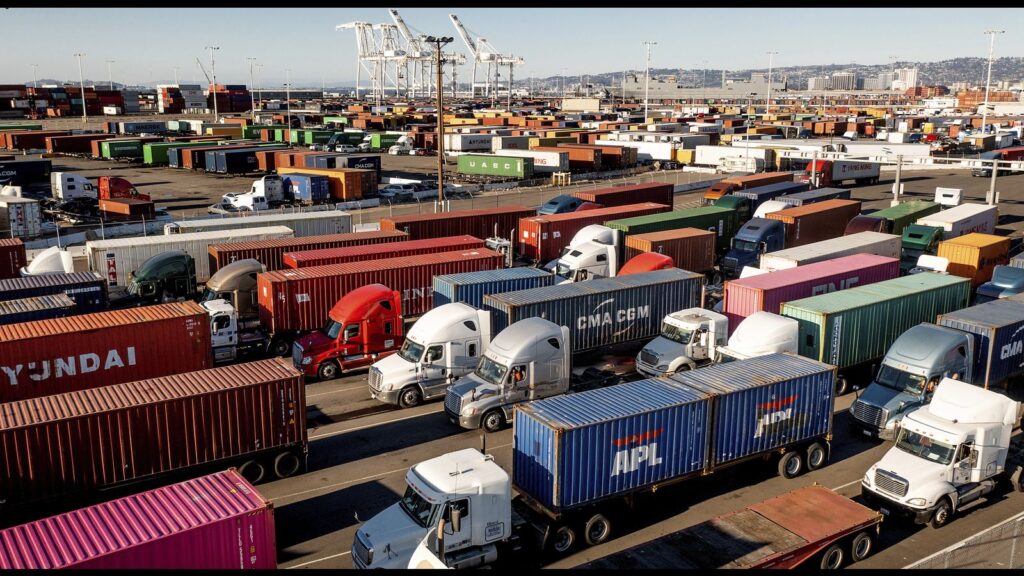
Trucks lined up to enter a Port of Oakland shipping terminal on Wednesday, November 10, 2021, in Oakland, California, as the effects of the Trump administration’s tariffs began to ripple through the economy. These tariffs, the highest imposed by the U.S. since the Smoot-Hawley Act of the 1930s, have been described as a declaration of war against both the American and international working class.
Former President Donald Trump has asserted that “billions of dollars in tariffs are now flowing into the United States of America.” However, this claim misrepresents the nature of tariffs, which are essentially a tax on imported goods, ultimately passed on to consumers in the form of higher prices. As a result, workers are already feeling the pinch through increased costs on everyday consumer goods.
The Economic Impact of Tariffs
The implications of these tariffs are profound, with potential job cuts, deteriorating working conditions, and wage reductions as businesses attempt to offset the increased costs. The central aim appears to be funding significant tax cuts for the wealthy and corporations, but the broader consequences could be far-reaching.
Historically, tariffs have had disastrous effects. The Smoot-Hawley Tariff Act of the 1930s is often cited as a contributing factor to the Great Depression, which eventually led to World War II. Trump’s economic policies echo this historical precedent, suggesting a similar trajectory of economic turmoil.
Historical Parallels and Economic Shifts
Following World War II, the capitalist system was reconstructed on the economic might of U.S. capitalism. However, this dominance has waned over the decades, beginning with President Nixon’s 1971 decision to remove the gold standard from the U.S. dollar, creating a fiat currency system. This shift marked the beginning of a series of financial crises, from the 1987 stock market crash to the 2008 financial crisis and the near-collapse of the financial system in 2020 during the COVID-19 pandemic.
The U.S. is now the most indebted country in history—$37 trillion and rising.
The Trump administration’s policies aim to address this existential crisis by establishing a “new global trading order,” positioning the U.S. as a dominant force in the global economy. However, this approach has sparked significant backlash both domestically and internationally.
Legal and Global Repercussions
The tariffs, ranging from 10 to 50 percent, are being implemented under the International Emergency Economic Powers Act (IEEPA) of 1977. Trump has justified these measures by citing a “national emergency” due to trade deficits. However, the Court of International Trade ruled this decision illegal in May, a ruling currently under appeal by the Trump administration.
In addition to IEEPA tariffs, specific commodities such as steel, aluminum, and computer chips are also targeted. These measures aim to dismantle the post-war economic system, with China identified as a primary target due to its perceived threat to U.S. economic and technological supremacy.
“The more deals we’ve done, the money coming in, it gets harder and harder for the Supreme Court to rule against us,” stated Treasury Secretary Scott Bessent.
Despite the aggressive stance, the U.S. has faced resistance, particularly from China, which retaliated with export controls on rare earth elements, crucial for the auto and military industries. This forced a temporary truce, but tensions remain high.
Domestic Consequences and Worker Impact
Domestically, the tariffs have already taken a toll on major corporations. General Motors reported over $1 billion in tariffs on automotive parts, while Stellantis and Nike anticipate significant financial hits. Smaller businesses are also suffering, with the U.S. Chamber of Commerce estimating a $202 billion annual tariff impact on small business importers.
According to Bloomberg, the combined annual tariff hit to small businesses is $202 billion, averaging $856,000 per firm.
These costs are inevitably passed down to workers, resulting in higher prices and job losses. The Trump administration’s assertion that tariffs boost jobs is contradicted by data showing minimal job growth in the steel industry compared to significant job losses in industries reliant on steel.
Call for International Solidarity
The International Committee of the Fourth International and its affiliated Socialist Equality Parties urge workers to unite against Trump’s economic policies. They advocate for a socialist program to address the global capitalist crisis, emphasizing the need for international solidarity among the working class.
This crisis, rooted in the contradictions of capitalism, is exacerbated by the globalization of production. U.S. imperialism seeks to resolve it through economic warfare both abroad and at home, but the working class must pursue a path of internationalist socialism to confront these challenges.
As the world grapples with the implications of these tariffs, the need for a unified response becomes increasingly urgent. The future of the global economy and the well-being of workers worldwide depend on the ability to navigate and counter these economic policies effectively.





